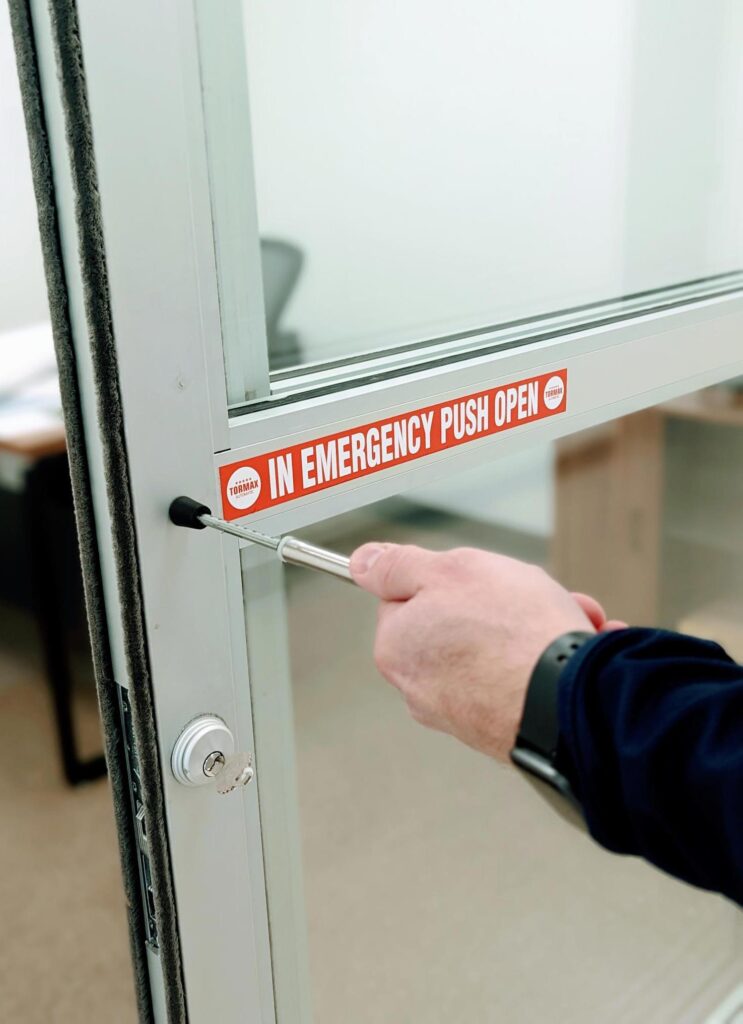
Adjusting automatic doors to account for wind force is critical to ensure proper functioning and safety. Ideally, you would want to have semi-annual inspections for evaluations on what’s needed to maintain the best wind force and door conditions for that time of year. Here are some general guidelines we reference during our PM inspections in making wind force adjustments on both automatic and manual doors:
Automatic Doors
Manufacturer’s Guidelines:
Manufacturers often provide detailed instructions on how to set the parameters based on the door model and environmental conditions.
Wind Load Calculation:
Consider the local wind conditions to calculate the expected wind load on the door. Factors such as the door size, shape, and the local wind speed will influence the force exerted on the door.
Adjusting Opening and Closing Speeds:
Increase the opening and closing speeds of the door to minimize the time the door is affected by wind forces. However, be cautious not to set the speeds too high, as it may compromise safety.
Adjusting to Reduced Opening:
Restricting the door from fully opening can reduce risk to doors being affected by winds.
Use Wind Load Sensors When Possible:
Some advanced automatic door systems come with wind load sensors. These sensors can detect increased resistance due to wind and adjust the door’s operation accordingly. Ensure these sensors are properly calibrated and functioning.
Install Windbreaks:
We sometime refer our customers to install windbreaks or barriers around the entrance to minimize the direct impact of wind on the door. This can be particularly effective in areas with consistent strong winds.
Regular Maintenance:
Keep the automatic door system well-maintained. Lubricate moving parts, check for any wear and tear, and ensure that the sensors are clean and functioning properly.
Professional Inspections*:
Periodically, have a professional AAADM certified technician inspect your automatic door. They can assess the overall condition, make necessary adjustments, and identify any potential issues that might affect the door’s performance in windy conditions. Ideally, twice year to allow for adjustments to be made for different climate conditions.
Manual Door Recommendations
Select a Suitable Door Closer:
Choose a door closer that is designed to handle the size and weight of the door, as well as the expected wind force in the location. Different door closers are rated for different door sizes and weights.
Correct Door Closer Installation:
Proper installation is crucial for the door closer to function effectively and handle wind force appropriately.
Adjust Closing Speed:
Most door closers have adjustable closing speed controls. Increase the closing speed to minimize the time the door is exposed to wind forces.
Adjust Latch Speed:
Some door closers have a separate latch speed adjustment. The latch speed controls the speed at which the door fully closes and latches. Adjusting this speed can help ensure a secure and complete closure, even in windy conditions.
Adjust Backcheck:
Backcheck is a feature that slows down the door as it approaches the fully open position. Adjusting the backcheck can provide additional resistance against wind forces when the door is opening.
Use Delayed Action Closers:
Consider using door closers with delayed action features. Delayed action closers delay the closing action, providing more time for people to pass through the door before it starts closing. This feature can be beneficial in windy conditions.
Consider Wind-Resistant Models:
Some door closers are specifically designed to resist wind forces. These models often have special features and adjustments to provide better control in windy environments. Consult with door closer manufacturers for models that are suitable for windy conditions.
Regular Inspections and Maintenance:
Keep the door closer well-maintained. Lubricate moving parts regularly and check for any signs of wear or damage. A well-maintained door closer is more likely to function properly under various conditions, including wind.
Professional Inspections*:
Have a professional technician inspect the door closer to ensure that it is in good working condition. They can make any necessary adjustments and identify potential issues that may affect the door closer’s performance in windy conditions.
Dead Stops:
Dead Stops restrict the closer arm from going past fully open positions when they act as a bumper against it.
Facility Door Solutions requires all their technicians to be AAADM certified. We always prioritize safety when adjusting automatic doors. If you are unsure about the appropriate settings or encounter issues, consult with us or seek assistance from a qualified AAADM technician familiar with automatic door systems. Facility Door Solutions encourages subscribing to their PM solutions to keep the overall cost of door ownership at its lowest and to ensure compliance with required life safety standards for your facility.

